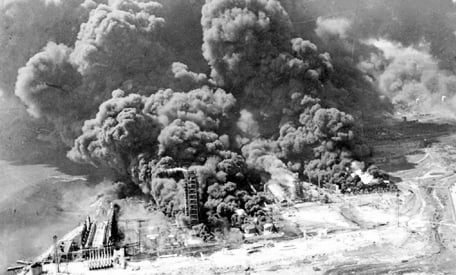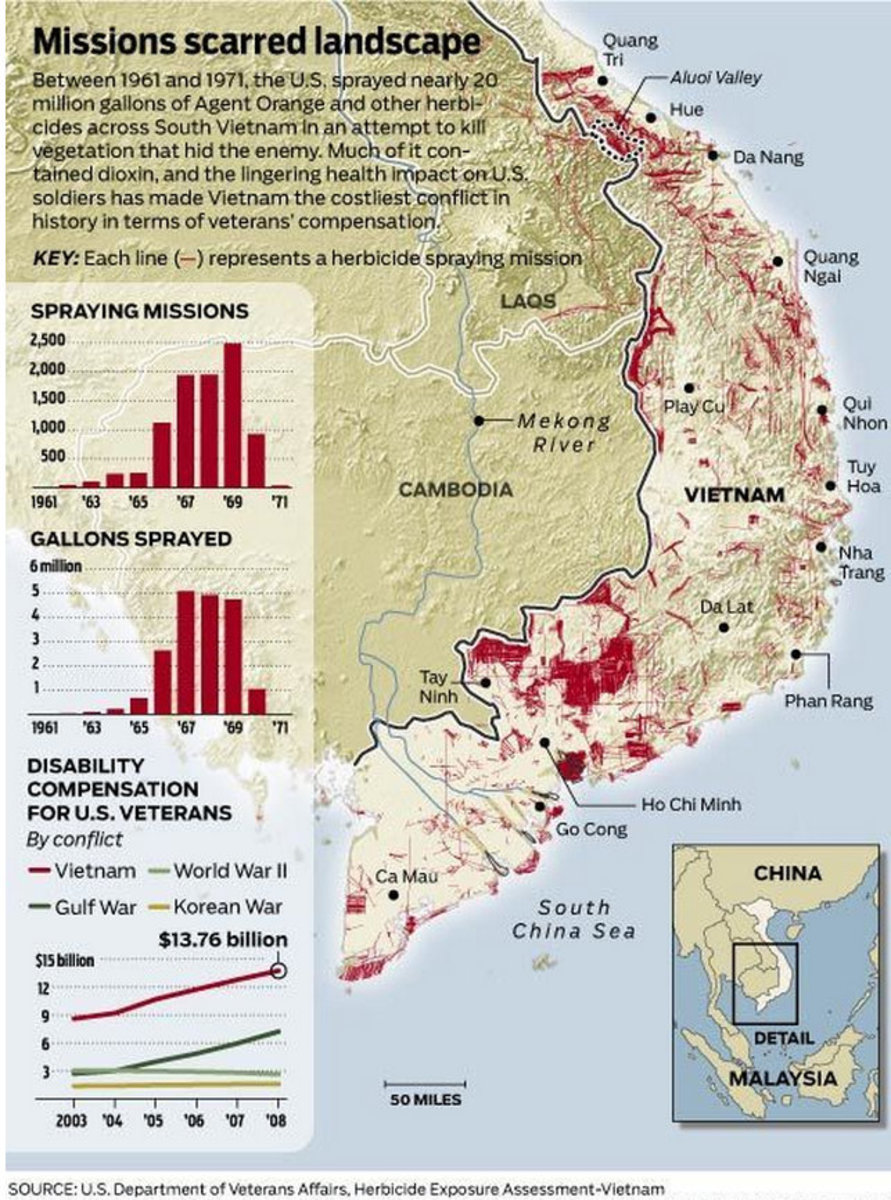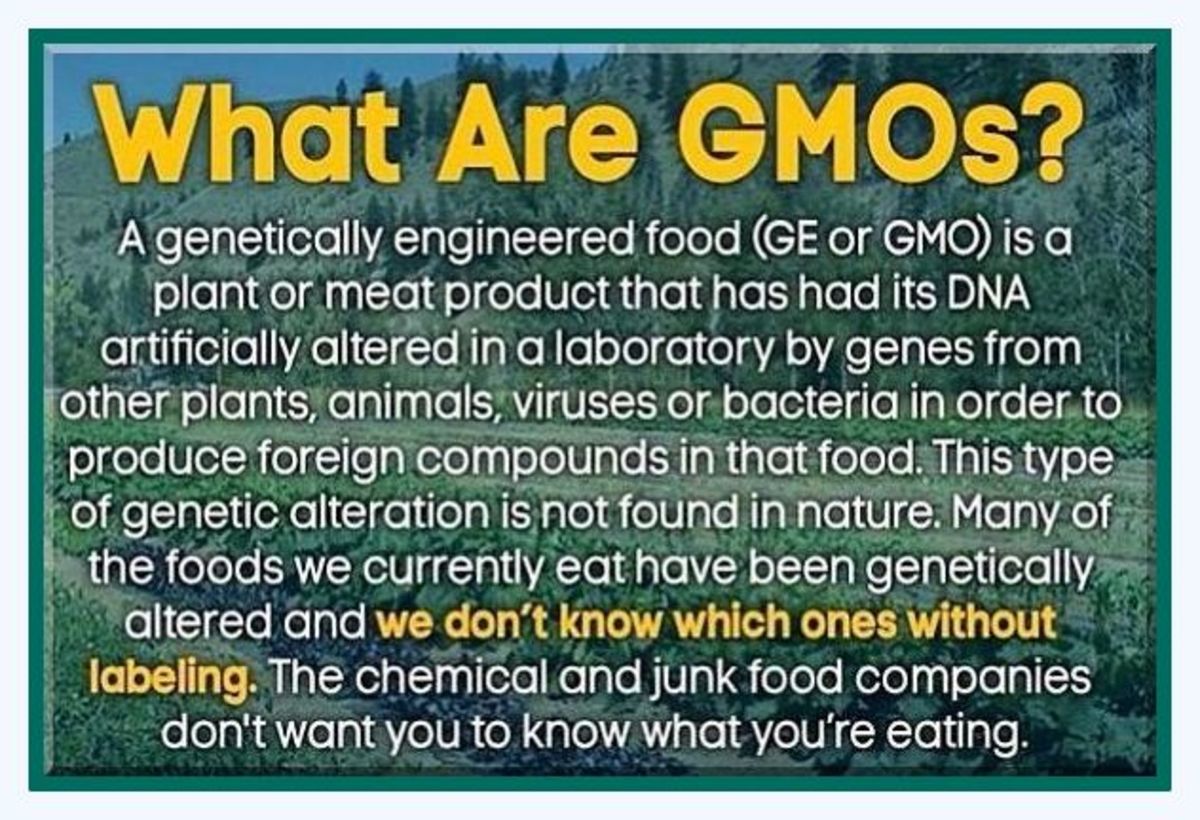A Fraud Called Agent Orange
This is the first in a series detailing the discovery, the military use, the legal battles over the damaging effects, and the massive ongoing cover-up of Monsanto's Agent Orange.

One has to wonder why there has been what appears to be a concerted effort to ignore and deny, even coverup the damages caused by exposure to Agent Orange. It's been sixty-nine years since Dr. Arthur Galston accidentally discovered the defoliant properties of triiodobenzoic acid, also known as TIBA. It's been sixty-three years since the Monsanto plant in Nitro, West Virgina, suffered an explosion that produced a plume of vapor and white smoke that drifted across the entire town. Monsanto manufactured herbicides which contained dioxins, a by-product of the manufacturing process. One of these herbicides was used as a main ingredient in the manufacture of Agent Orange.
At the time of the explosion, a fine, black and powdery residue coated the interior of the plant buildings, as well as the workers inside. In a matter of a few days, the workers began to experience the skin eruptions of chloracne, a long lasting and disfiguring condition. Some employees reported feelings of intense pain in their limbs, chest, and trunk areas. Doctors noticed a very strong odor coming from the contaminated employees who were described as “excreting a foreign chemical through their skins”. The medical report stated that the explosion “caused a systemic intoxication in the workers involving most major organ systems.” In an effort to downplay the event, Monsanto claimed that the contaminant was only an irritant to the skin and “fairly slow acting”.

In the following years leading up to the Vietnam War, there were several more incidents that should have alerted chemical companies like Monsanto and Dow, that their herbicides were potentially deadly to human beings. Yet, they willingly sold their death chemicals to the US government for use against the North Vietnamese Army. Instead of giving warning of the toxic effects the chemicals would have against the civilians and the military personnel, they collected their million dollar contracts.
Members of the military were told the chemicals were harmless, that they were being used to deprive the enemy of cover. The American fighting men were told the chemicals were being used in an effort to protect their lives. Our fighting men accepted what they were told. They didn't question the safety of their water for cooking, drinking, and bathing. They didn't question the hazards of having silly battles where they sprayed the “safe” defoliating chemicals, drenching their opponents in the liquid.
It wasn't until after they were home safely in the bosoms of their families that they began to get sick. Some developed chloracne, liver dysfunction, and cancers. Many, many veterans underwent major personality changes that were severe and often violent, causing them to succumb to drugs and alcohol. Personality changes were blamed on the emotional burden of their experiences. But veterans began to suspect that their illnesses were a result of their time in Vietnam. They began to suspect the “harmless” chemical known as Agent Orange, as well as some of the other herbicides often referred to as the “Rainbow Herbicides” because they were named after the colors blue, white, pink, green and purple.
Claims were made to Veteran's Affairs in an effort to receive financial aid for medical treatment and/or disability. These claims were denied. Paul Reutershan took a different approach. He sued the chemical companies that manufactured the herbicides. After he filed his suit in 1978, others flocked to join him. He urged them to file separate lawsuits, knowing that a class action suit would not provide for the millions that would be necessary to pay for so many terrible illnesses. Six years later when the lawsuit was settled for a paltry $180 million dollars, Paul was not there. He had died only a few months following his filing.

News of the pending lawsuit must have certainly brought on a wave of anxiety for the herbicide manufacturers, especially Monsanto and Dow, and they jumped to action. No one has been able to determine if Judge Weinstein was on the take or if he had been instructed on how he was to handle the pending lawsuit.
It was the judge who decided that the many individual lawsuits would be lumped together into one class action suit. It was the judge who appointed the attorneys and then proceeded to bully them until they agreed to the $180 million settlement that HE had crafted, letting Monsanto and others off the hook for liability. He denied fees to those attorneys who didn't cooperate with his plan. Judge Weinstein punished those veterans who “opted out” of the class action to pursue their own lawsuit by creating two new rules of law in order to keep them away from a jury. Instead of allowing a jury to determine credibility of witnesses and decide on facts of dispute, he decided that the veterans' expert witnesses weren't credible, thereby denying them their right to a jury trial. However, the judge DID accept evidence presented by both the manufacturers and the US government. He deemed their evidence to be valid and conclusive proof that Agent Orange had not caused the injuries and illnesses.
During the years following the initial filing for suit, further dioxin research was being conducted by independent researchers and the conclusive results were unsettling. Dioxin hazards studies completed throughout the 1970's and into the 80's were giving up damning evidence, but the VA continued to deny claims for Agent Orange related illnesses. The only claims honored were for those of chloracne. As a consequence, Congress passed the Veterans' Dioxin and Radiation Exposure Compensation Standards Act of 1984.
The purpose of the Standards Act was to respond to the tens of thousands of veterans' claims. There had yet to be established a causal relationship between exposure of Agent Orange and the many diverse illnesses being represented by claimants, but evidence of dioxin toxicity was mounting. Congress mandated that the VA Administrator resolve any doubt IN FAVOR of the veteran seeking compensation.
“It has always been the policy of the Veterans Administration and is the policy of the United States, with respect to individual claims for service connection of diseases and disabilities, that when, after consideration of all the evidence and material of record, there is an approximate balance of positive and negative evidence regarding the merits of an issue material to the determination of a claim, the benefit of the doubt in resolving each such issue shall be given to the claimant.”
More From Terri Meredith
- The Roots of Agent Orange
This is the second in a series of articles detailing the discovery, the military use, the legal battles faced by victims, and the massive ongoing cover-up of the deadly chemical manufactured by Monsanto, Agent Orange. Step into the aftermath of the V - Secret Agent Orange: A Monsanto Web of Deceit
This is the third in a series of articles detailing the discovery, the military use, the legal battles faced by victims, and the massive ongoing cover-up of the deadly chemical manufactured by Monsanto, Agent Orange. Read here the web of lies spun by - Agent Orange and the Agents of Deception
This is the fourth in a series of articles detailing the discovery, the military use, the legal battles faced by victims, and the massive ongoing cover-up of the deadly chemical manufactured by Monsanto, Agent Orange. The machinations of factions in - Agent Orange Blues: How Vietnam Navy Veterans Were Scuttled
This is the fifth in a series of articles detailing the discovery, the military use, the legal battles faced by victims, and the massive ongoing cover-up of the deadly chemical manufactured by Monsanto, Agent Orange. Discover the battle of US Navy Ve
The VA continued to deny over 31,000 veterans, insisting on proof of causation in exchange for compensation, until veterans' groups prosecuted a successful legal action finding that the VA had made unpermissible demands.
With concerns growing after the first studies of human exposure to AO (Agent Orange), Congress commissioned a large scale epidemiological study to determine potential health effects. It was to be conducted by the VA, but their reluctance and procrastination at getting started convinced Congress that some other agency should be appointed and the responsibility was given to the CDC in 1983.
When the results of the study were examined in hearings before the Human Resources and Intergovernmental Relations Subcommittee in 1989, it was ascertained that the design, implementation and conclusions suggested that political pressures had interfered with authenticity.
For information regarding the outright fraud perpetrated in manufacturing biased studies, read the Dept. of VA classified document report by Admiral E. R. Zumwalt, Jr. dated May 5, 1990.
http://www.gulfwarvets.com/ao.html
American taxpayers footed the bill for a $63 million expenditure to study the health effects of Agent Orange/Dioxins on human beings. The only thing we got for better than six years was nothing more than a multimillion dollar coverup enacted by the Reagan administration, the military, and both Monsanto and Dow Chemicals. Through it all, our veterans were suffering and dying without care or compensation from the very people who had sent them to battle.
WHY WAS THIS PERMITTED TO HAPPEN???
If this is an important issue to you or you find the information helpful, please pass it on by clicking the Tweet, Like, +1, or Pinterest buttons provided at the top of the page.
Also feel free to leave a comment or tell your own Agent Orange story.









